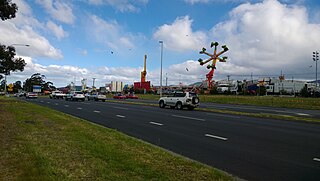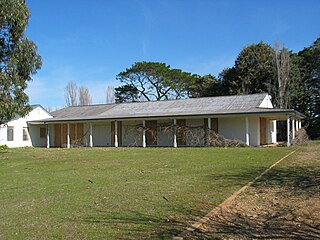
Canberra is the capital city of Australia. Founded following the federation of the colonies of Australia as the seat of government for the new nation, it is Australia's largest inland city and the eighth-largest Australian city overall. The city is located at the northern end of the Australian Capital Territory at the northern tip of the Australian Alps, the country's highest mountain range. As of June 2023, Canberra's estimated population was 466,566.

Queanbeyan is a city in south-eastern New South Wales, Australia, located adjacent to the Australian Capital Territory in the Southern Tablelands region. Located on the Queanbeyan River, the city is the council seat of the Queanbeyan-Palerang Regional Council. At the 2021 census, the Queanbeyan part of the Canberra–Queanbeyan built-up area had a population of 37,511.

Belconnen is a district in the Australian Capital Territory in Australia. The district is subdivided into 27 divisions (suburbs), sections and blocks. As at the 2021 census, the district had a population of 106,061 people; and was the most populous district within the Australian Capital Territory (ACT).

The Sydney Royal Easter Show, commonly shortened to The Easter Show or The Show, is an annual show held in Sydney, Australia over two weeks around the Easter period. First held in 1823, it comprises an agricultural show, an amusement park and a fair and combines the elements of each, showcasing the judging of livestock and produce. The Royal Agricultural Society of New South Wales is responsible for the event. Queen Victoria awarded the society and its show the right to use the word "Royal" in its name.

The Royal Adelaide Show is an annual carnival and agricultural show run by the Royal Agricultural and Horticultural Society of South Australia. It is held at the Adelaide Showground, a dedicated venue located in Wayville, a suburb of Adelaide, South Australia.

The Ekka is the annual agricultural show of Queensland, Australia. Its formal title is the Royal Queensland Show, and it is held at the Brisbane Showgrounds. It was originally called the Brisbane Exhibition, but it is more commonly known as the Ekka, short for "exhibition". It is run by The Royal National Agricultural and Industrial Association of Queensland (RNA).

The Royal Hobart Show is an annual event held in October at the Royal Showgrounds in Glenorchy, Tasmania, Australia. It is the largest of the Royal Shows held in cities and towns around the state by the Royal Agricultural Society of Tasmania. The event focuses on the rural exploits of Tasmanians with events such as livestock judging and wood chopping. Also popular at the event are show bags and rides.

Hall is a town in the district of Hall, in the Australian Capital Territory in Australia. Is situated on the north side of the Australian Capital Territory. At the 2021 census, the village had a population of 298 people. It is surrounded by open country and has a rural appearance. Hall has retained a village character. The town features historic buildings that existed before the establishment of Canberra.

The Perth Royal Show is an annual agricultural show held in Perth, Western Australia at the Claremont Showground. It features informational exhibits, agricultural competitions and animal showcases, a sideshow alley and rides, and showbags. It has been held for over 100 years and is organised by the Royal Agricultural Society of Western Australia. It is held during the spring school holidays, either during the last week of September or the first week of October and at its peak, attracted attendance of around 460,000 people.

The Melbourne Royal Show is an agricultural show held at Melbourne Showgrounds every September. It is organised by Melbourne Royal and has been running since 1848. Each year Melbourne Royal Show attracts attendances of up to half a million people.
The Indigenous All-Stars is an Australian rules football team composed of players that identify as Indigenous Australian or with an indigenous culture.

Ginninderra is the name of the former agricultural lands surrendered to urban development on the western and north-western fringes of Canberra, the capital of Australia. Ginninderra corresponds with the watershed of Ginninderra Creek, which is now in part occupied by the Canberra districts of Belconnen and Gungahlin.
The Royal Launceston Show is an annual event held in Carrick in October and is hosted by the Royal National Agricultural and Pastoral Society of Tasmania (RNAPS), established in 1873. The show marks a public holiday that is observed in northern Tasmania only.

Gold Creek Homestead is a 140-year-old stone and brick building located off Gungahlin Drive in Ngunnawal a north-western suburb of Canberra, Australia. It is adjacent to the Grove Ngunnawal retirement village currently being developed by Lend Lease.
The National Poultry Show is the largest poultry show in the Southern Hemisphere, held quadrennially on the year of the Olympics and attracting exhibitors from across Australia.
The Victorian Farmers Federation (VFF) is an Australian non-profit membership based advocacy and lobby group that represents farmers in Victoria. The organisation represents its members in lobbying state and federal government on policy matters that affect farmers and regional communities. The VFF is a member organisation of the national farm lobby group the National Farmers Federation.
Henry ‘Babe’ Curran (1896–1964) was one of the most successful Australian woolgrowers during the industry's boom in the 1940s and 1950s.

Deasland was a historic homestead at Ginninderra in Canberra’s north on the Barton Highway. It was demolished in early 2022 due to 'Mr Fluffy' asbestos contamination.

The Ginninderra blacksmith's shop is one of the most significant historical sites of the Australian Capital Territory. It was one of the first sites to be listed on the ACT Interim Heritage Places Register in 1993. The workshop is also of national importance as it is one of only a few known surviving stand-alone blacksmith shops in Australia; although, many farm-based smithies have survived. The building remains in stable condition, but there is no firm plan concerning its long-term management and it remains fenced-off and inaccessible to the public.
The COVID-19 pandemic in the Australian Capital Territory is part of the ongoing worldwide pandemic of the coronavirus disease 2019 caused by severe acute respiratory syndrome coronavirus 2. After one case of the delta variant in mid-August 2021, the Territory went into lockdown. By 26 September, the ACT had its first COVID-19 related death since mid-April 2020, nearly 18 months, followed by 3 more deaths in the first week of October 2021. 28 deaths during the outbreak since 12 August 2021 brought total deaths to 31, the most recent being on 8 February 2022.















